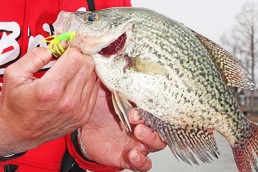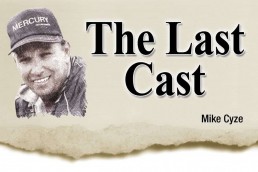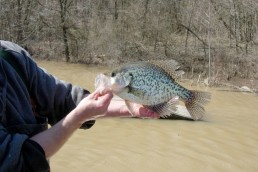Water Temperatures Lead to Crappie Success
SHARE THIS POST
Deer are creatures of habit and your hunting success will drastically improve if you learn their patterns. It’s no different with crappie. They are creatures of habit, too. A big factor in learning their movements is to learn how water temperature changes their patterns.
32-40 degrees
Crappie have been tight to cover and holding along creek and river channel ledges. The number one rule to fishing these temperatures is “go slow.” A fast presentation will seldom work in cold water.
Bert Bennett, guide and tournament angler who lives in southeast Missouri, says he will connect a thermometer to one of his poles making it easy to drop down and reel up. “The key is to quickly eliminate unproductive water. Once I find the active zone I can eliminate a lot of the lake and focus upon the right depth, cover and presentations. I’ll usually be on a point or creek channel ledge, close to cover. Fish are sluggish, so my bait will be sluggish, too.” He likes a non-active 1.5- to 1.75-inch-long jig or a small minnow.
40-50 degrees
Fish are still deep or mid-depth. However, a slight warming trend will likely cause the fish on a 20-foot break to move up and suspend at 3 or 4 feet. They’ll be straight up over the break, but at the depth where the baitfish are located. You’ll see the baitfish on your locator, but not the crappie, because the boat spooks them and the locator’s cone angle is too narrow at that depth.
Crappies are also making their way into creeks and coves in mid-depth waters. Jigs in the 1.75-inch range should work fine. You still don’t need them to be really active, so try grub style and tubes. Small and medium size minnows are best, too.
A wild card spot can be in 2 or 3 feet of water when shad move up shallow. This is a test-fish situation that will make you a hero or zero.
50-60 degrees
It’s time for great fishing. Check your water temperatures often. Any shallow coves or bays can warm quickly and become a hotspot.
Are you enjoying this post?
You can be among the first to get the latest info on where to go, what to use and how to use it!
Seven-time crappie classic champ, Ronnie Capps from Tennessee, says, “My fishing seems to be great until the water temperature hits 59 degrees. Until then, fish are predictable and can be caught along shallow or mid-depth drops near spawning locations. Once the water reaches 59 degrees, they become unstable and can change their pattern in one day.” He says he will be using medium size jigs 1.75 or 2 inches in length and/or medium minnows.
60-70 degrees
“Not all fish go into spawn at the same time,” says Capps. “Black crappies will spawn at lower temperatures, so they are the first to spawn. White crappies like a little warmer water, so they will be behind the blacks. Fish will be scattered with some in at the banks, while some are out in deeper water. Medium baits work well, but some of the bigger fish may want a big bait.”
The spawn peaks at 67 degrees. It can last for a week or ten weeks, depending upon the weather.
70-80 degrees
The spawn is ending. Experts agree that post-spawn is a tough time because fish scatter and suspend while recovering from the spawn. Bennett says, “It’s so important to know that crappies will spawn at different depths. But once you know the depth range of the spawning crappies you can go anywhere on the lake after the spawn and catch crappies at the same depth. However, they will be scattered and suspended in deep water with a few relating to cover.”
Now can be a good time to fast troll a Road Runner head with a Charlie Brewer Slider Grub or Southern Pro Hot Grub. You can also pull crankbaits.
80 and hotter
Fish may be on a drop-off or just suspended. Docks, heavy vegetation, and open water are all potential crappie spots, depending upon a lake’s characteristics. Docks call for lightweight jigs. Other typical spots call for a large minnow or a jig/minnow combo. Crankbaits rule when fishing open water for suspended fish.
The cycle reverses until it starts over in the winter. Pay attention to temperatures to improve your degree of success crappie fishing.
MWO
SHARE THIS POST
Did you enjoy this post?
You can be among the first to get the latest info on where to go, what to use and how to use it!
Tim Huffman
Tim Huffman specializes in crappie fishing, is editor for two crappie magazines, as well as writing for several others. In 2018, he published his sixth book, Limiting Out for Crappie, available at Amazon. His first article appeared in MidWest Outdoors in 1988.




[…] Crappies are found abundantly in temperatures ranging from 50 to 75 degrees. This is an optimum temperature for pre-pawning and so they feed enormously and move around in shallow waters. As crappies are constantly searching for food, they can be caught easily within this temperature range. If you want to read more about the ideal temperatures, Midwestoutdoors has a detailed piece on it here. […]
High water and abnormally high temperatures have crappie in pre-spawn mode in southern lakes right now. The crappie, in places like Grenada Lake, MS, are currently scattered due to high water, with the spawn ready to explode if water temperatures continue to warm a few more degrees. The spawn will migrate up into the middle states next month and then on into the northern waters around May or June. Water temperature is an important factor to fast, relatively shallow, crappie action, with 50 to 75 being good, 60 to 70 fantastic.